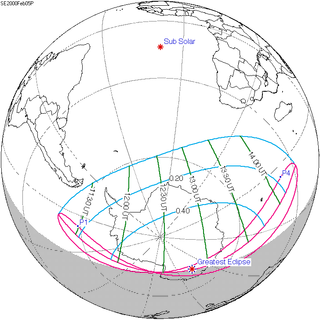Solar eclipse of February 5, 2000
| Solar eclipse of February 5, 2000 | |
|---|---|
| Type of eclipse | |
| Nature | Partial |
| Gamma | −1.2233 |
| Magnitude | 0.5795 |
| Maximum eclipse | |
| Coordinates | 70°12′S 134°06′E / 70.2°S 134.1°E |
| Times (UTC) | |
| Greatest eclipse | 12:50:27 |
| References | |
| Saros | 150 (16 of 71) |
| Catalog # (SE5000) | 9507 |
A partial solar eclipse occurred on February 5, 2000. A solar eclipse occurs when the Moon passes between Earth and the Sun, thereby totally or partly obscuring the image of the Sun for a viewer on Earth. A partial solar eclipse occurs in the polar regions of the Earth when the center of the Moon's shadow misses the Earth. It was only visible over Antarctica.
Images
Related eclipses
Solar eclipses 1997-2000
This eclipse is a member of a semester series. An eclipse in a semester series of solar eclipses repeats approximately every 177 days and 4 hours (a semester) at alternating nodes of the Moon's orbit.[1]
The partial solar eclipses on July 1, 2000 and December 25, 2000 occur in the next lunar year eclipse set.
| Solar eclipse series sets from 1997 to 2000 | ||||||
|---|---|---|---|---|---|---|
| Descending node | Ascending node | |||||
| Saros | Map | Gamma | Saros | Map | Gamma | |
120 Totality in Chita, Russia |
March 9, 1997 Total |
0.9183 | 125 | September 2, 1997 Partial |
−1.0352 | |
130 Totality near Guadeloupe |
February 26, 1998 Total |
0.2391 | 135 | August 22, 1998 Annular |
−0.2644 | |
| 140 | February 16, 1999 Annular |
−0.4726 | 145 Totality in France |
August 11, 1999 Total |
0.5062 | |
| 150 | February 5, 2000 Partial |
−1.2233 | 155 | July 31, 2000 Partial |
1.2166 | |
Metonic series
The metonic series repeats eclipses every 19 years (6939.69 days), lasting about 5 cycles. Eclipses occur in nearly the same calendar date. In addition, the octon subseries repeats 1/5 of that or every 3.8 years (1387.94 days). All eclipses in this table occur at the Moon's descending node.
| 22 eclipse events between September 12, 1931 and July 1, 2011 | ||||
|---|---|---|---|---|
| September 11–12 | June 30–July 1 | April 17–19 | February 4–5 | November 22–23 |
| 114 | 116 | 118 | 120 | 122 |
 September 12, 1931 |
 June 30, 1935 |
 April 19, 1939 |
 February 4, 1943 |
 November 23, 1946 |
| 124 | 126 | 128 | 130 | 132 |
 September 12, 1950 |
 June 30, 1954 |
 April 19, 1958 |
 February 5, 1962 |
 November 23, 1965 |
| 134 | 136 | 138 | 140 | 142 |
 September 11, 1969 |
 June 30, 1973 |
 April 18, 1977 |
 February 4, 1981 |
 November 22, 1984 |
| 144 | 146 | 148 | 150 | 152 |
 September 11, 1988 |
 June 30, 1992 |
 April 17, 1996 |
 February 5, 2000 |
 November 23, 2003 |
| 154 | 156 | |||
 September 11, 2007 |
 July 1, 2011 | |||
References
- ^ van Gent, R.H. "Solar- and Lunar-Eclipse Predictions from Antiquity to the Present". A Catalogue of Eclipse Cycles. Utrecht University. Retrieved 6 October 2018.
External links





